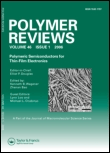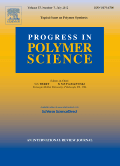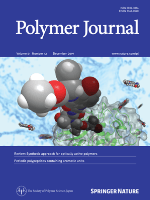
JOURNAL OF POLYMER RESEARCH
Scope & Guideline
Empowering Discoveries in Polymer Research
Introduction
Aims and Scopes
- Polymer Synthesis and Characterization:
The journal publishes research on various synthetic methods for polymers, including traditional and novel techniques such as RAFT, ATRP, and click chemistry, as well as characterization techniques that elucidate polymer structure and properties. - Biodegradable and Bio-based Polymers:
There is a strong emphasis on the development of environmentally friendly materials, such as biodegradable polymers and bio-based composites, addressing the need for sustainability in polymer applications. - Nanocomposites and Hybrid Materials:
Research on nanocomposites, which enhance the properties of polymers through the incorporation of nanoparticles, is a key focus area. The journal explores how these materials can improve mechanical, thermal, and electrical properties. - Functional Polymers and Smart Materials:
The journal highlights advancements in functional polymers that respond to external stimuli (like pH, temperature, or light) and their applications in fields such as drug delivery, sensors, and actuators. - Polymer Processing and Engineering:
Research on the processing techniques for polymers, such as electrospinning, 3D printing, and injection molding, is also a significant area of interest, investigating how processing affects material properties. - Polymer Applications in Medicine and Environmental Science:
The journal features studies on the application of polymers in biomedical fields, such as drug delivery systems and tissue engineering, as well as their use in environmental remediation and sustainable practices.
Trending and Emerging
- Sustainable and Eco-friendly Polymers:
There is a significant increase in research dedicated to sustainable and eco-friendly polymers, including biodegradable plastics and materials derived from renewable resources, driven by global environmental concerns. - Smart and Functional Polymers:
Emerging themes include the development of smart polymers that respond to environmental stimuli, which are increasingly being applied in drug delivery systems, sensors, and adaptive materials. - Advanced Nanocomposite Materials:
The trend towards the use of nanocomposites for enhancing the properties of polymers is growing, with a focus on integrating novel nanomaterials to achieve superior mechanical, thermal, and electrical characteristics. - Polymer Applications in Biomedicine:
Research on the application of polymers in biomedical fields, particularly in drug delivery and tissue engineering, is rapidly increasing, reflecting the advancement of polymer science in addressing health-related challenges. - Polymer Recycling and Upcycling:
An emerging focus on the recycling and upcycling of polymers, including the development of methods to reprocess and reuse polymer waste, is gaining traction as sustainability becomes a key concern in material science.
Declining or Waning
- Conventional Polymer Processing Techniques:
There seems to be a declining focus on traditional processing techniques, such as extrusion and casting, as researchers increasingly explore more innovative and efficient methods like 3D printing and electrospinning. - Basic Polymer Chemistry:
Research that solely focuses on fundamental polymer chemistry without application or advanced characterization appears to be diminishing, as there is a stronger inclination towards applied research with immediate relevance to technology and sustainability. - Non-biodegradable Polymer Studies:
There is a noticeable decrease in publications centered on non-biodegradable polymers, as the field shifts towards the exploration of sustainable materials and biodegradable alternatives. - Single-Function Polymers:
Research on polymers with single functionalities is waning as the interest grows in multifunctional materials that offer combined properties for enhanced performance in various applications.
Similar Journals

INTERNATIONAL JOURNAL OF POLYMER ANALYSIS AND CHARACTERIZATION
Exploring innovative methodologies in polymer characterization.International Journal of Polymer Analysis and Characterization is a distinguished scholarly publication dedicated to the field of polymer science, with a focus on innovative methodologies and significant advances in the analysis and characterization of polymeric materials. Published by Taylor & Francis Ltd in the United Kingdom, this journal serves as a vital resource for researchers, professionals, and students deeply engaged in Analytical Chemistry, Chemical Engineering, and Polymer Science. With a convergence spanning from 1995 to 2024, it holds a Q3 ranking in the 2023 category quartiles for its valuable contributions to the fields of Analytical Chemistry, Chemical Engineering, and Polymers and Plastics. Despite being a non-open access publication, its rigorous peer-review process and comprehensive coverage of current trends ensure that the journal remains a crucial platform for disseminating impactful research. The journal is indexed in various databases, underscoring its relevance and quality in the academic community. Exploratory studies and articles that push the boundaries of polymer analysis find a welcoming home within these pages, making it an essential read for those aiming to stay at the forefront of polymer research.

Polymer Reviews
Driving excellence in biomedical engineering and beyond.Polymer Reviews, published by Taylor & Francis Inc, is an esteemed journal dedicated to the intricate and evolving field of polymer science. With its ISSN 1558-3724 and E-ISSN 1558-3716, the journal has established a significant presence among researchers and practitioners alike, evidenced by its impressive categorization in the Q1 quartiles across multiple disciplines, including Biomedical Engineering, Materials Chemistry, and Renewable Energy. Since its inception in 2006 and continuing through 2024, Polymer Reviews has consistently aimed to advance the knowledge base of polymer applications and innovations, providing a platform for comprehensive review articles that stimulate further research and inspire practical solutions. The journal, ranking within the top percentile across several Scopus categories, underscores its impact and relevance in a rapidly developing scientific landscape. Though not an open-access journal, it remains a vital resource for those invested in the future of materials science and engineering.

IRANIAN POLYMER JOURNAL
Connecting Scholars in Chemical Engineering and PolymersWelcome to the Iranian Polymer Journal, an esteemed publication encompassing a rich history since its inception in 1996 and extending its scholarly reach up to 2024. Published by Springer from Switzerland, this journal stands out in the fields of Chemical Engineering, Materials Chemistry, and Polymers and Plastics, proudly holding a Q2 category ranking in each of these disciplines for 2023. With an ISSN of 1026-1265 and an E-ISSN of 1735-5265, the journal serves as a vital resource for researchers, professionals, and students, offering insights into polymer science and interdisciplinary applications. Although not an open-access journal, it presents an invaluable platform for high-quality research dissemination and robust peer-reviewed articles. With Scopus rankings indicating its respected position within the academic community, the Iranian Polymer Journal is committed to advancing knowledge and fostering innovation in polymer-related studies, making it an essential addition to your research library.

ACS Macro Letters
Advancing the Frontiers of Macromolecular ScienceACS Macro Letters, published by the American Chemical Society, is a leading journal in the fields of Inorganic Chemistry, Materials Chemistry, Organic Chemistry, and Polymers and Plastics. Established in 2012, this journal has swiftly ascended to the forefront of chemical research with an impressive reputation, as evidenced by its 2023 Scopus rankings placing it in the first quartile across multiple categories. The journal's objective is to disseminate timely and concise articles that advance the study of macromolecules and their applications, making it an essential resource for researchers, professionals, and students alike. With a focus on fostering innovation and facilitating collaboration within the chemical community, ACS Macro Letters presents a robust platform for scientists to share their groundbreaking findings. Being based in the United States, it serves as a central hub for global discourse in the chemical sciences, although it does not currently offer Open Access options. The journal's commitment to high-quality content is further underscored by its prestigious impact factor and acceptance into elite academic quartiles, signifying its influence and importance in shaping future research.

POLYMER BULLETIN
Connecting Researchers through Cutting-edge Polymer InsightsPOLYMER BULLETIN is a prominent journal in the field of polymer science, published by SPRINGER in Germany. Established in 1978, this peer-reviewed journal focuses on the latest research and developments in polymer chemistry, materials science, and condensed matter physics, boasting a commendable impact factor indicative of its rigorous academic standards. With a Q2 ranking in multiple categories including Chemistry (Miscellaneous), Condensed Matter Physics, Materials Chemistry, and Polymers and Plastics, POLYMER BULLETIN serves as an essential resource for researchers, professionals, and students aiming to stay abreast of innovative findings and methodologies within these interdisciplinary landscapes. Although the journal does not currently offer open access, it provides invaluable insights and data that significantly contribute to the advancement of polymer science. For more information and to access published articles, visit the journal's page on the Springer website.

PROGRESS IN POLYMER SCIENCE
Empowering Researchers with High-Impact FindingsPROGRESS IN POLYMER SCIENCE is a prestigious academic journal published by PERGAMON-ELSEVIER SCIENCE LTD, dedicated to advancing the field of polymer science. With an ISSN of 0079-6700 and an E-ISSN of 1873-1619, this journal has established itself as a leading source of high-quality research since its inception in 1967. It ranks in the top quartile (Q1) across multiple categories including Ceramics and Composites, Materials Chemistry, Organic Chemistry, Polymers and Plastics, and Surfaces and Interfaces, reflecting its strong reputation and impact within the scientific community. The journal features rigorous peer-reviewed articles that not only contribute to theoretical advancements but also emphasize practical applications of polymer science in various industries. Although it is not an open-access journal, it remains accessible through institutional subscriptions and provides invaluable insights and data for researchers, professionals, and students alike. PROGRESS IN POLYMER SCIENCE is essential reading for anyone looking to stay abreast of the latest developments and innovations in this dynamic field.

POLYMER-KOREA
Fostering Collaboration in Chemical Engineering and PolymersPOLYMER-KOREA, an esteemed publication by the POLYMER SOC KOREA, serves as a vital platform for disseminating groundbreaking research in the domains of Chemical Engineering, Materials Chemistry, and Polymers and Plastics. Founded in 1996, this journal aims to bridge the gap between academic inquiry and industrial application, fostering innovation in polymer science. With an ISSN of 0379-153X and an E-ISSN of 2234-8077, POLYMER-KOREA provides a rigorous peer-reviewed environment, although it does not currently offer open access options. Based in Seoul, South Korea, and slated for converged years up to 2024, the journal is indexed in Scopus and has been ranked in the 2023 Q4 category in its respective fields, highlighting its niche yet competitive position within the academic community. Researchers, professionals, and students alike will find the journal an invaluable resource, honing in on critical advancements and fostering collaborative discussion within the spectrum of polymer science.

INTERNATIONAL POLYMER PROCESSING
Elevating Standards in Polymer Science and EngineeringINTERNATIONAL POLYMER PROCESSING, published by WALTER DE GRUYTER GMBH, serves as a crucial platform for professionals and researchers in the fields of Chemical Engineering, Industrial and Manufacturing Engineering, and Materials Science, particularly focusing on polymers and plastics. With its ISSN 0930-777X and E-ISSN 2195-8602, this journal has been in circulation since 1988 and continues to expand its contributions to contemporary research trends through to 2024. Ranking in the third quartile across multiple categories, including Chemical Engineering (miscellaneous) and Materials Chemistry, it offers insightful and rigorous peer-reviewed articles that enhance the understanding of polymer processing technologies and innovations. This journal is vital for anyone engaged in polymer science and engineering, providing both theoretical and practical perspectives that advance the field. Although it does not provide open access, the journal's content is indispensable for academia and industry professionals looking to stay at the forefront of polymer research.

POLYMER JOURNAL
Exploring the Dynamics of Polymers and PlasticsPOLYMER JOURNAL, published by SpringerNature in the United Kingdom, is a premier academic platform dedicated to the field of polymer science. Since its inception in 1971, this journal has become an essential resource for researchers and professionals interested in the latest advancements in materials chemistry, polymers, and plastics. With its robust H-index and a consistent ranking in the top quartiles of its categories—Q2 in both Materials Chemistry and Polymers and Plastics—POLYMER JOURNAL demonstrates a strong impact in the scientific community. It holds significant recognition in Scopus rankings, occupying the 68th percentile in Materials Chemistry and the 67th percentile in Polymers and Plastics. The journal's commitment to publishing high-quality research articles enables it to serve as a key reference point for innovative studies, theoretical developments, and practical applications in polymer science. Although it is not an open-access journal, researchers and students gain valuable insights through its extensive archives and rigorous peer-reviewed content, making POLYMER JOURNAL a vital source of knowledge for anyone engaged in this dynamic field.

JOURNAL OF POLYMER SCIENCE
Fostering Collaboration in the Evolving World of PolymersJOURNAL OF POLYMER SCIENCE, published by WILEY, is a premier, open-access journal dedicated to advancing the field of polymer science and its applications. With an ISSN of 2642-4150, it offers a platform for high-quality research and innovative ideas, contributing significantly to the understanding of polymaterials and their functionalities. The journal is recognized for its exceptional impact within various categories, consistently achieving Q1 rankings in Materials Chemistry, Physical and Theoretical Chemistry, and Polymers and Plastics, demonstrating its influential presence in the academic community. As of 2023, it holds a distinguished position in Scopus rankings, underscoring its relevance and rigorous peer-review process. By facilitating open access to vital research findings, the JOURNAL OF POLYMER SCIENCE plays a crucial role in fostering collaboration and knowledge transfer among researchers, professionals, and students, paving the way for innovative developments in polymer applications and materials science.